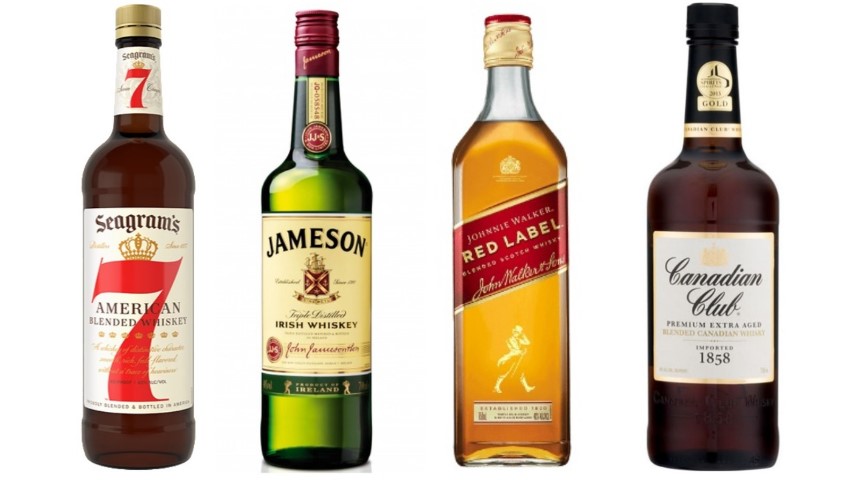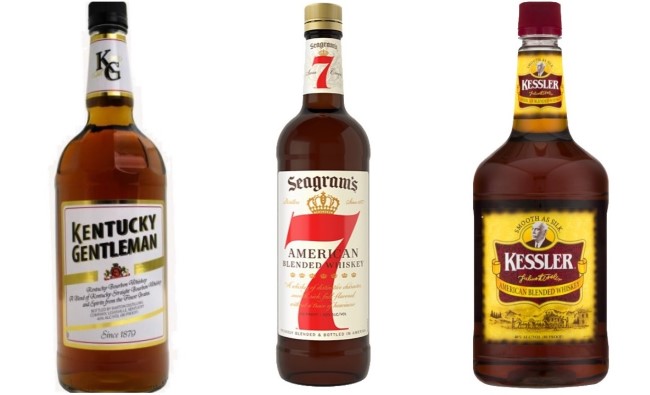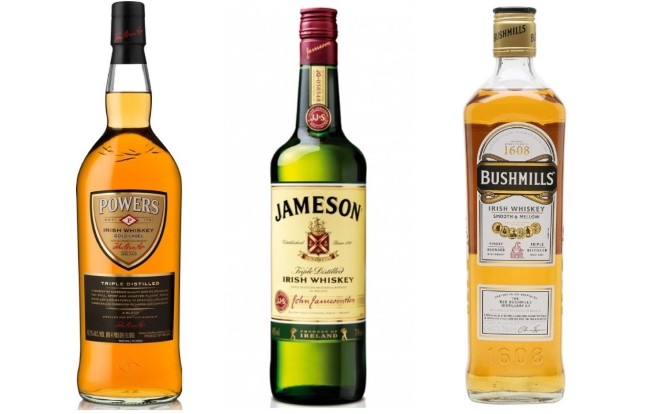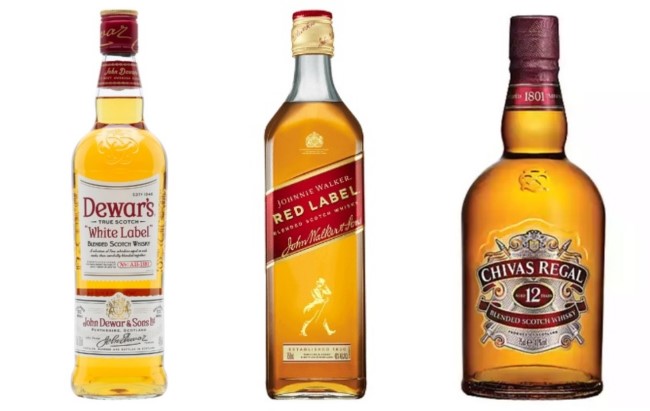
Cocktail Queries: What Is Blended Whiskey, and Why Is It So Cheap?
by Jim VorelCocktail Queries is a Paste series that examines and answers basic, common questions that drinkers may have about mixed drinks, cocktails and spirits. Check out every entry in the series to date.
If you’re an average spirits consumer browsing the whiskey aisle of a package store, you’re eventually going to face the following question: What are all these “blended” whiskeys on the bottom shelf, exactly? What does the “blended” label mean? Do their cheap price tags automatically imply a low level of quality, or are some of them actually fit to drink?
When it comes to the latter question, you can look at our blind tasting of 13 bottle-shelf, bourbon-adjacent whiskeys and see for yourself. But actually defining “blended whiskey” is considerably more complicated, owing to one thing in particular: The term “blended” means very different things in different nations.
Let’s start, then, by explaining what “blended whiskey” means in the USA.
American Blended Whiskey
Notable brands: Seagram’s 7, Kessler, Kentucky Gentleman, Ten High, Banker’s Club

Most of the blended whiskey consumed in the U.S. is very cheap stuff, although there are some notable, more recent exceptions. This is due to the definition, which is built around creating an extreme budget product, but can also be interpreted differently.
According to the federal definition, “blended whiskey” must contain a minimum (but can contain more) of 20% straight whiskey, while the rest can essentially be any other style of alcohol. In practice, this almost invariably means the remainder is made of grain neutral spirits—heavily distilled, flavorless, pure alcohol that is akin to high-proof vodka made from any kind of grain. These spirits are then blended together and watered down to the desired proof.
Classic American blended whiskeys such as Seagram’s 7, then, typically contain a bit more than 20% straight bourbon—that’s bourbon that has been aged for at least two years in newly charred oak, meeting all the other qualifications to be “bourbon”—and are filled out by those inexpensive grain neutral spirits. That makes these bottles VERY cheap—often $10 or less per 750 ml bottle—and often harsh in flavor, as they typically possess a very “raw,” boozy taste that is more akin to whiskey-flavored vodka than it is to proper bourbon.
However, these blended whiskeys are just the start of a spectrum. Blended whiskeys that contain at least 51% straight whiskey, for instance, gain an additional descriptor, being able to call themselves “blended bourbon whiskey,” or “blended rye whiskey.” Brands like Ten High and Kentucky Gentleman fall into this designation. Things can also head in the opposite direction, as a whiskey with a mere 5% or less straight bourbon in it can call itself “spirit whiskey,” a label that is not very common. Other products competing in the whiskey bottom shelf, meanwhile, aren’t necessarily blended whiskeys—Early Times, for instance, is priced similarly but contains no neutral grain spirits. Rather, it’s whiskey that is aged in used rather than newly charred barrels, meaning it also misses the “bourbon” definition in its own way.
However, groups of different straight bourbons or straight ryes can also be blended together into a single bottle. The title “a blend of straight bourbons” implies that every bourbon in the bottle was aged for at least two years, and the same would be true of “a blend of straight ryes.”
Recent years have also seen the growth of more premiumized blended whiskey brands that contain no grain neutral spirits. Hotaling & Co.’s J.H. Cutter Whisky would be one example, as it is a blend of straight bourbon, straight rye, and malted rye whiskey. Jim Beam’s new Little Book is another, as each batch is a blend of very different, distinct whiskeys. The first Little Book release, for instance, contained Kentucky straight bourbon, malt whiskey, rye whiskey and 13-year-old corn whiskey, and was released at barrel proof. That’s a very different beast from the likes of Seagram’s 7.
Still, at the end of the day, when you see American “blended whiskey” on the bottom shelf of the whiskey aisle, and the price is under $15, there’s a good chance that it contains a large amount of grain neutral spirits. Use that information however you like, but know that the meaning of “blended whiskey” in other countries is quite different.
Canadian Blended Whiskey
Notable brands: Canadian Club, Crown Royal, J.P. Wiser’s

Whereas when one says “American whiskey,” the consumer’s initial thought is probably something like straight bourbon, the Canadian industry is far more associated with blended whiskey. On a basic level, this is a function of how the Candian industry distills its products—not with mash bills of multiple grains, but as single-grain distillations (such as corn or rye) that are aged separately and then blended to achieve specific flavor profiles. This gives the distilleries a great deal of flexibility, and the ability to create new product concepts quickly—something I learned during my trip to Canada visiting the Hiram Walker and Sons Distillery —and it also results in the majority of Canadian whiskey products being blends of multiple distillates.
With that said, Canadian blended whiskey is a very different thing from the cheap, bottom-shelf stuff that largely carries that title in the U.S. To begin with, all whiskey in Canada is federally required to age in wooden casks for at least three years. Neutral grain spirit isn’t used, either—rather, many Canadian blends are a combination of whiskeys that are single distilled (like almost all U.S. whiskey) and double or triple distilled, which are referred to as “light whiskeys.” These double-distilled whiskeys are taken to a very high proof, removing more “impurities” and resulting in a less flavorful, more neutral spirit. Canadian blended whiskeys, then, ultimately present as somewhat lighter than American styles such as bourbon, owing to that portion of double-distilled whiskey in the blend.
In recent years, the Canadian whiskey industry has moved toward more non-blended, single-grain releases, such as 100% rye whiskeys that are distilled only a single time, but blended whiskeys still make up all the most prominent flagship brands.
Blended Irish Whiskey
Notable brands: Jameson, Bushmills, Powers

As in Canada, the leading commercial flagships in both Ireland and Scotland are blended whiskeys, but once again the rules of exactly what denotes a “blended whiskey” are a bit different than they are in the U.S. or our northern neighbor.
Blended Irish whiskey carries a fairly simple definition: It’s simply any bottle that is a blend of two or more different whiskey types, between the three the Irish government defines: Malt whiskey, grain whiskey, and “single pot still whiskey,” a unique Irish style that involves both malted AND unmalted barley in the mash. If you combine two of those styles in a single batch? That’s blended Irish whiskey. Like Canadian whiskeys, they must be aged in some kind of wood (new or used oak, typically used) for at least three years.
However, the “grain whiskeys” involved in the production of Irish blended whiskey are, as in Canadian whiskey, usually distilled multiple times (often three times) to a very high proof, which strips them of much of their natural, grain-derived flavors. That makes for a strong, neutrally flavored distillate that is then mixed with a portion of more flavorful malt whiskeys to make almost all the best-known Irish whiskey brands, from Jameson to Bushmills.
Of course, there is also a robust market for single malt whiskey and single pot still whiskey in Ireland as well, and these whiskeys typically are viewed as premium products that command higher price points than their blended brethren. With that said, extra-aged or special edition bottlings of blended Irish whiskeys can also carry higher price tags.
Blended Scotch Whiskies
Notable brands: Johnnie Walker, Dewar’s, Chivas Regal, Cutty Sark

Several of the tenets of blended Irish whiskey hold true here—in the sense that most Scottish blends are combinations of malt and grain whiskies—but there are also a few differences. As in Ireland, the classic Scottish blended whiskies make up all the most famous bulk brands—many of the brands that consumers associate with the idea of “scotch” in general.
However, you’ll also see a few additional fields within the world of scotch, including “blended malt whiskey” and “blended grain whiskey.” The former is what it sounds like: A collection of malts (no grain whiskey) from different distilleries that have been blended together. The latter is its opposite, and less common—a collection of grain whiskies from different distilleries combined into one. Blended malts have become more common over time, in products such as the popular Monkey Shoulder, a blend of three Speyside malts from different distilleries.
As in Ireland or the U.S., the blended scotch whiskies, while popular, ultimately aren’t the products in the marketplace that garner the most critical attention—that’s typically reserved for single malt whiskies, which tend to be how individual distilleries make a name for themselves. Blended scotch whiskies are therefore more common for casual drinking and mixing purposes, although high-end blends from the likes of Johnnie Walker have long established the precedent of premium blends as well.
It should be noted that several other world whisky markets, and Japan in particular, follow this basic outline of what “blended whisky” would entail—most of them are less expensive and found on the lower shelf, but some (such as Hibiki) have managed to market themselves more successfully as premium products. So it ultimately is with “blended whiskey” as a category—it’s still typically the domain of the bottom shelf, but there are increasingly more interesting examples to be found. It’s a category that rewards careful reading of the bottle … and understanding of the terminology.
Jim Vorel is a Paste staff writer and resident liquor geek. You can follow him on Twitter for more drink writing.